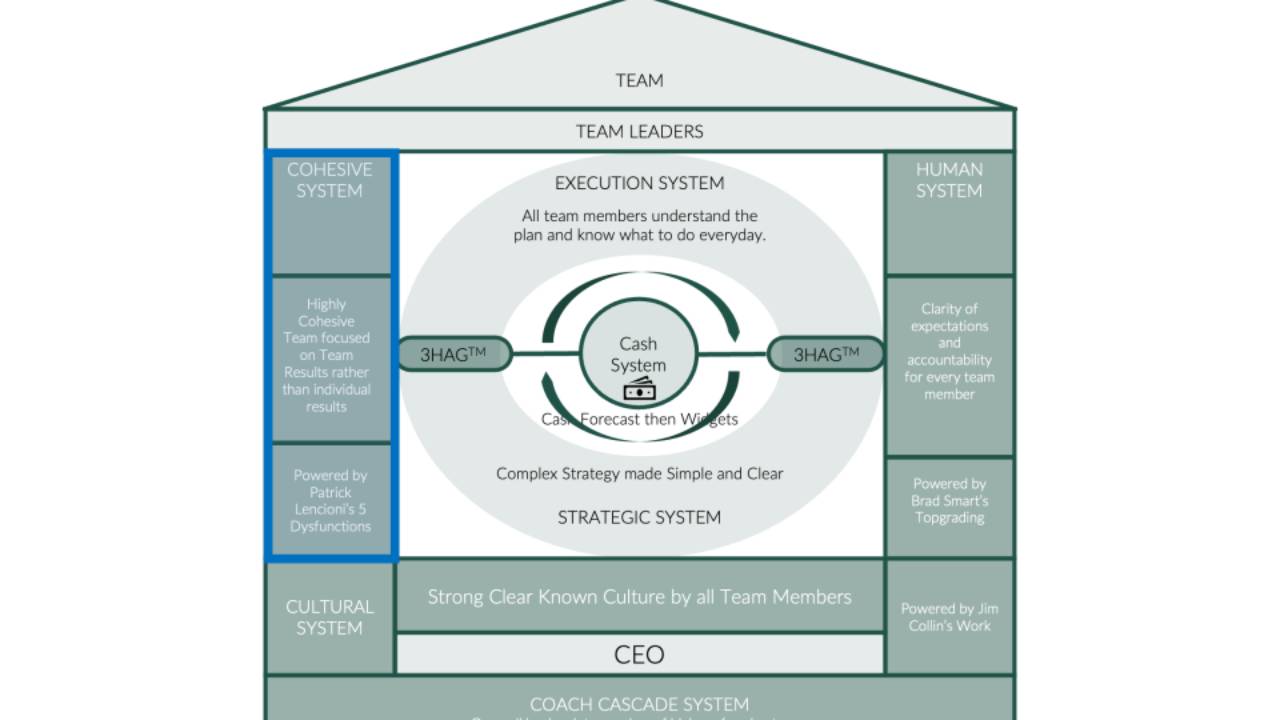The Metronomics Cohesive System
Nov 02, 2022
In my recent article “The Seven Systems of Metronomics” I summarised the seven systems in the Metronomics Compound Growth System. This article is the next in the series of seven individual articles that “deep-dives” into each of the seven systems. This next article is all about the cohesive system, the system tasked with creating and maintaining balanced and cohesive teams.
As Jim Collin’s said “First Who, Then What”. To be successful in business you have to have a great team around you and that starts with the leadership team. If your leadership team is dysfunctional you are not going to achieve what you want. The Cohesive System, which is powered by Patrick Lencioni’s “Five Dysfunctions of a Team”, shows you how to create trust, manage conflict, get commitment and accountability and through this process and ultimately, create results. The Cohesive System works from the beginning to build balance cohesion within the leadership team and from there, cascade down to all team members.
A key component of the Cohesive System is the”Five Dysfunctions of a Team” model by Patrick Lencioni. In this business fable, Pat explains the metamorphosis of a highly dysfunctional leadership team into a functional team in the context of a fictitious company.

Dysfunction #1 - Absence of Trust
The first dysfunction is the absence of trust. Teams that lack trust are essentially unwilling to be vulnerable within the group. They are less likely to be genuinely open with each other about their thoughts, concerns, weaknesses and mistakes which makes it impossible to build a foundation of trust. The absence of trust also makes it unlikely that teams will engage in constructive conflict, the topic of the second dysfunction.
Dysfunction #2 - Fear of Conflict
Teams that do not trust each other will not engage in passionate, unfiltered debate of ideas, issues and concerns and without this debate, disagreements or differences of opinion within the leadership team do not get resolved. They fester and re-emerge further down the track wasting leadership time and delaying decisions. If this (healthy) conflict doesn’t happen, teams are unlikely to commit, the third dysfunction in the model.
Dysfunction #3 - Lack of Commitment
Without conflict, teams don’t work things through and as team members feel they haven’t had their voice heard, they rarely, if ever buy in and commit to decisions even if they appear to do so in meetings. Team members who have not committed to a decision will not be accountable for that decision, which leads to the fourth dysfunction.
Dysfunction #4 - Avoidance of accountability
When teams do not commit, they will avoid accountability. Without committing to a clear outcome and a clear plan of action even the most diligent and focused people will hesitate to call their peers on actions, outcomes and behaviours counterproductive to the good of the team. Not surprisingly, lack of accountability will inevitably not deliver the results desired by the team.
Dysfunction #5 - Inattention to results
The final team dysfunction is the inattention to results. When a team does not hold each other to account, they create an environment where individuals put their own needs ahead of the collective interests and goals of the team. Ultimately, teams that lack accountability rarely produce the results the team has set themselves.
To create a highly functional, cohesive and performant teams, all of these dysfunctions must be worked through and minimised. Unfortunately, if there is one weak link, team cohesion will suffer.
Want to know if your team is functional? You can take a quick 10 minute assessment here.
How does Metronomics build Team Cohesion?
Work to build team cohesion is actually embedded within the metronomics process. Teams often ask me when we will start working on team cohesion when the reality is we have been working on it since day1, we just don’t call it out explicitly.
During the 2 Day Kick-Off and within the first hour, we start working on cohesion during the introduction and by running through Patrick Lencioni’s “Personal Histories” exercise.
At our quarterly meetings we continue working through cohesive questions and working on self awareness using tools such as DISC, Values, Strength Finder and the “Six Working Genius” (also by Patrick Lencioni).
As we progress through the quarters we introduce additional techniques such as “Left and Right” where each member of the leadership team shares what they appreciate about the person to their left and right. We are showing the team how to give positive feedback to their peers. As team cohesion increases we will gradually introduce more challenging feedback mechanisms. We continue to build on this as we progress.
Ultimately, we are looking for the team cohesion to build to a level that we call Team Cohesion 2.0. This can take time but when you get there, you’ll be amazed at how tight, aligned, healthy and productive a highly cohesive team can be.
This article was written by Ged Roberts and Aoife Roberts (October 2022).

